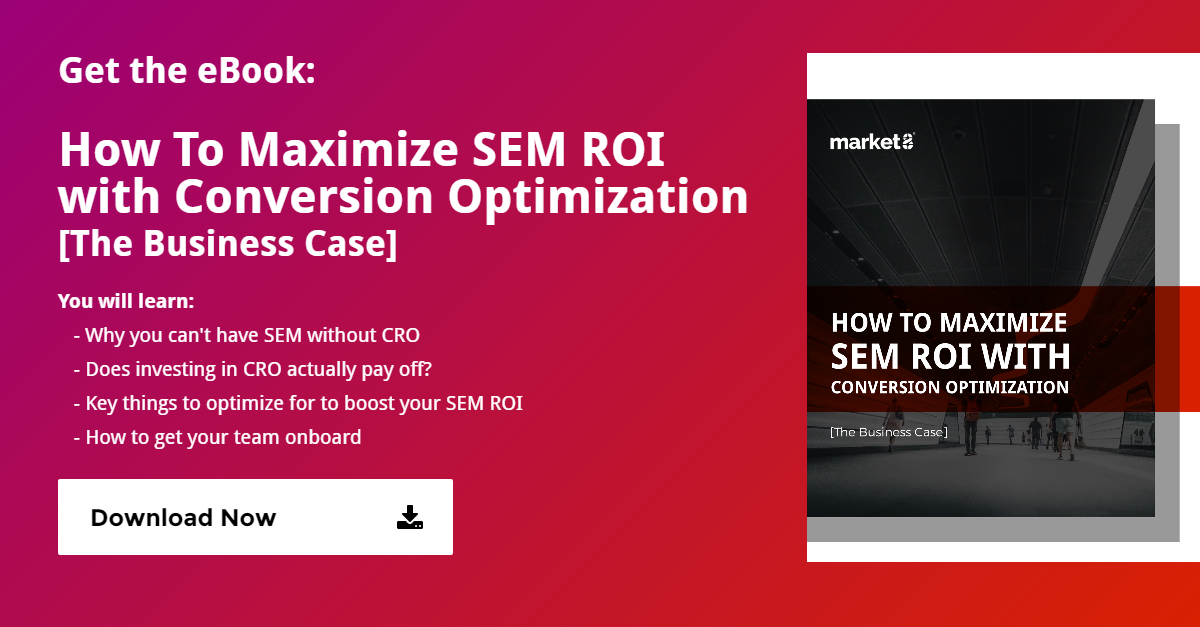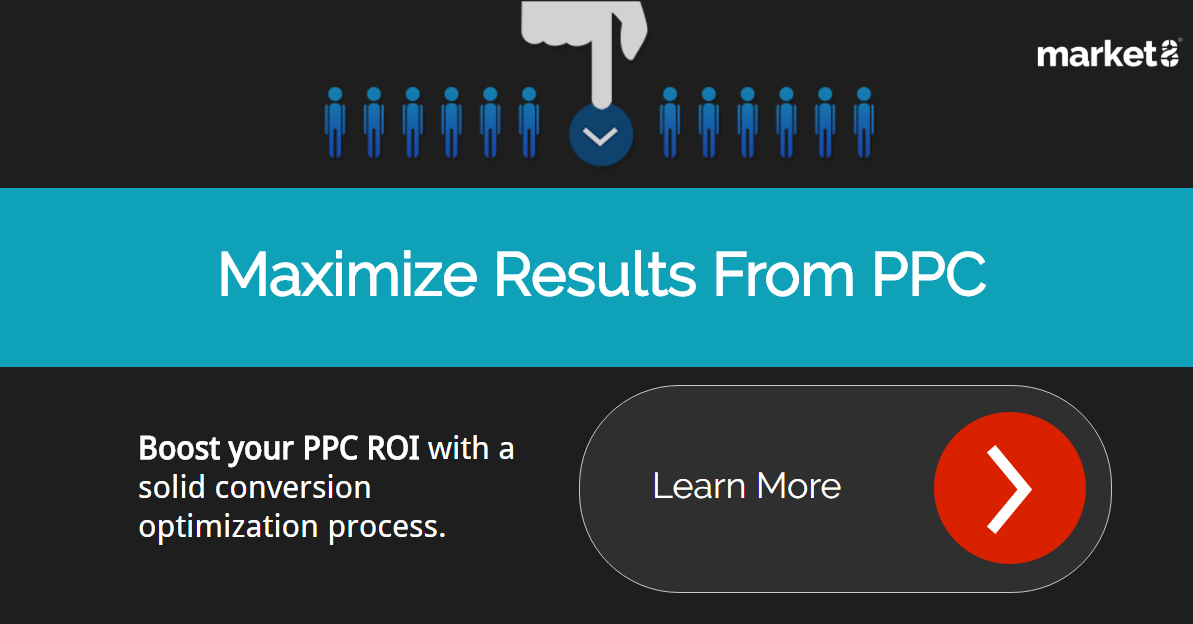Marketers are spending more on ads than ever before. Ad spend is expected to continue to grow at an annual rate of 12.1% by 2019, naturally driving advertising costs upwards. This article series explains the importance of focusing on improving the ROI of your SEM, and explores critical things you need to focus on optimizing from your ads, all the way to your landing page conversions.
The advertiser's logic is clear: spend some money on campaigns that target the very audience you want exactly when they want you; You spend some money to make more money.
Most advertisers view of the advertising flow looks like this:
1. Drive eyeballs to your site
2. More sales / opt-ins.
This is a myopic view. You need to provide the means for the buyer to act on. So from your buyer's perspective, the flow is actually more like this:
1. Search for what I want
2. Click and check if this is relevant & trustworthy - compare, etc.
3. Buy/opt-in
If you are not doing something to optimize your buyer's experience in step 2, you are probably wasting a lot of money.
Why You Can’t Have SEM Without CRO: The Business Case
Interest in SEM as a search term has been on a steep rise in the last 5 years (2012-2016). In fact, PWC forecasted that digital advertising spend will continue to grow at a CAGR of 12.1% between 2014 and 2019 to a staggering 240 billion.
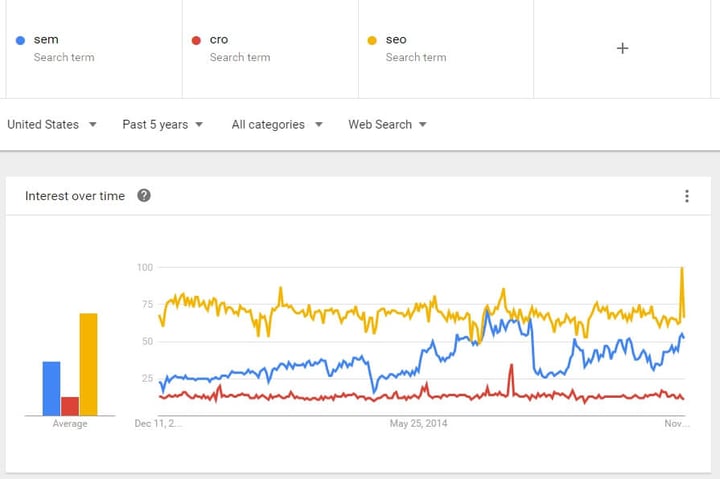
What does this mean to you? It means that as bid competitions across all digital advertising increase, advertising costs will inevitable go up. Supply and demand.
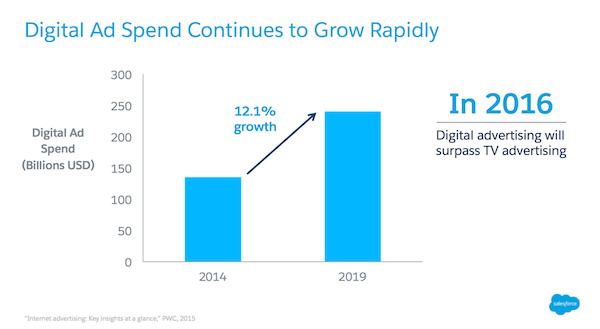
With advertising costs bound to go up, the pressure on getting your ads to perform and to ultimately yield revenue for your firm will also increase. I'll repeat that in big:
With advertising costs bound to go up, the pressure on getting your ads to ultimately yield revenue for your firm will also increase."
This means that you will need to think about how to improve the efficiency of your ad budget:
- First optimizing your ads, so that click-thru-rates are high and cost-per-action are as low as possible.
- Second, making sure that your paid traffic is landing on pages that convert those visitors into leads and customers.
The science that makes the second point possible is Conversion Optimization. And although most marketers know what this is, the interest in CRO (Conversion Rate Optimization) has been increasing at a slower rate than interest in SEM. This is indicative of the gap between marketer's spend in acquiring a lead vs. converting it (HubSpot, 2016): "For every $92 spent on acquiring a lead, only $1 is spent on converting it..."
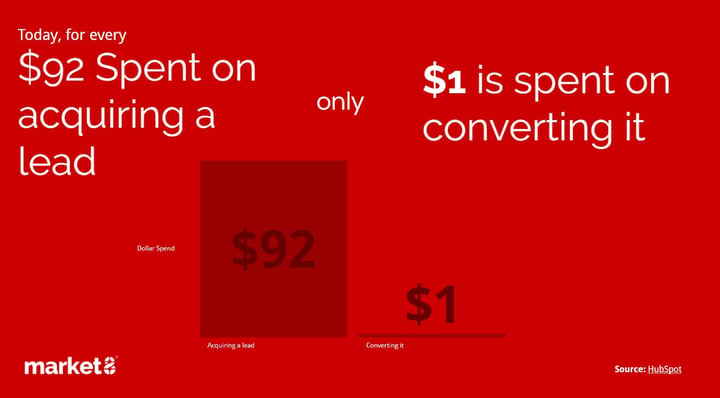
Can you imagine?
This is like an overall consensus on buying a mediocre baseball team, spend 99% of the budget in getting the team into all major championships, travel expenses to getting them there, and only 1% of the budget in training and coaching the team. Something worst than the Detroit Tigers in the 2003 season...
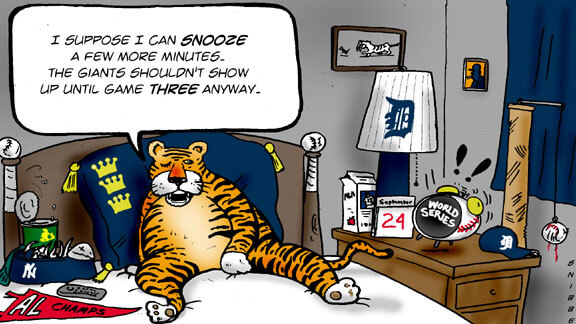
As WordStream's Founder and MobileMonkey’s CEO, Larry Kim, puts it:
If you’re spending thousands of dollars on search, you’d be crazy to not be spending on tools and software that can help you optimize your website.”
I'd add talent to that quote from Larry. Good, analytical talent that's trained on the scientific methodology to increase conversions: gather data, create hypothesis, design tests, and learn from them.
Does it actually pay off to add CRO to my SEM process?
The real answer depends on your particular situation, but I'd say this: If after you implement a solid CRO process, you still find that it wasn't worth it, you are either an outlier with great future vision, or have been plain lucky and your luck won't replicate in other situations.
I have yet to see a single case where intuition and "common sense" consistently beat a scientific-method-based conversion optimization process over the long run.
But, ok, here is a simple scenario for a hypothetical ACME software firm, spending $10k/mo in SEM. A conversion optimization process can be applied to the entire funnel, but here we'll first model improvements of 20, 30 and 50% to the conversion of the landing pages used for the campaigns:
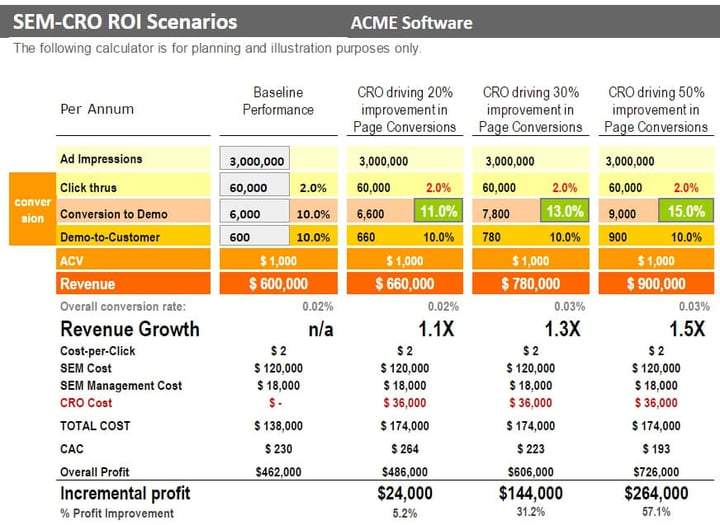
Investing $3k/month in CRO in this scenario could already yield a 5.2% profit improvement with a mere 10% improvement in conversions.
Now, let's apply the CRO process to the SEM side of things to improve the click-thru rates by the same 20, 30 and 50%:

Compounding the CRO effects on both SEM campaign management AND their corresponding landing pages yield up to a 142% profit improvement.
The combined effect when a critical mass of ad spend is there, and the ACV or conversion value justifies it, can yield very juicy profits for your organization, depending on how dramatic the lifts in conversions are.
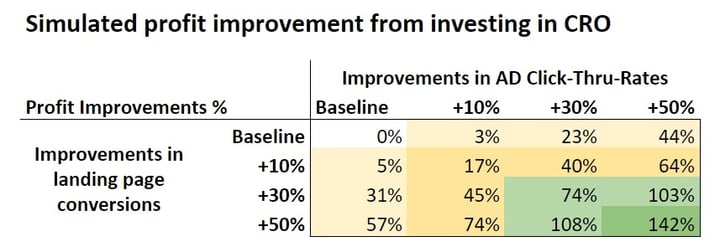
How Conversion Rate Optimization (CRO) boosts the performance of your SEM
As Optimizely’s content marketing manager, Cara Harshman, puts it:
In an ideal scenario, the amount of money you make from SEM should be more than the amount of money you spend.”
I'd say it's a pretty basic level expectation. It’s all about making a profit, and for this to happen the buyer needs to go through a series of microconversions; for a buyer to flow through the whole funnel from seeing an ad, to becoming a lead, subscriber or customer (whatever the ultimate objective is) a number of things must happen:
- Keyword Bid: Your ad must show in an ad platform's search results
- Ad Impression: Your buyer must look at your ad vs. other ads and quickly evaluate that your ad matches his expectations best
- Clicks: Your buyer must click on your ad
- Landing page visits: Your buyer will go to your landing page and quickly find what she expected to find
- On-page conversions: Your buyer must take an action; subscribe, download, buy, whatever your ultimate conversion objective was.
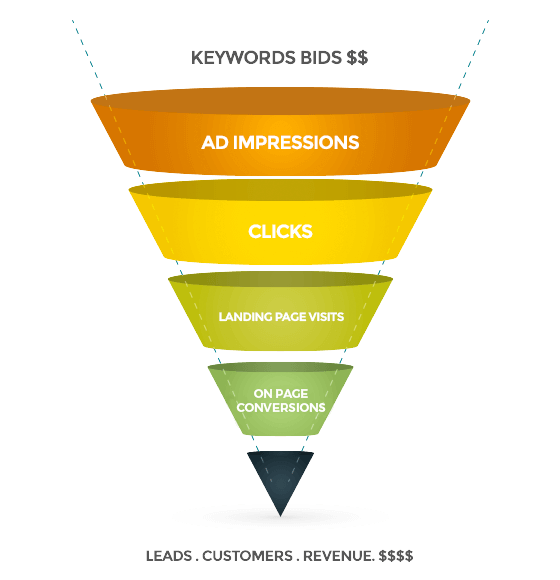
Of course a fraction of the people that sees your ad will end up fulfilling the ultimate conversion objective. However your job is to minimize your Type I and Type II errors. That is:
- Minimize the exposure to & conversion of the wrong kind of lead, and
- Minimize the dropoff of the right kind of lead from the conversion funnel
In other words: Try to eliminate the wrong kind of leads, while maximizing the right kind of leads. And that’s exactly where CRO comes into the picture to complement your SEM strategy.
As Harrison Jones, writing in Search Engine Land, declares (change SEO for SEM and the quote is still relevant):
Relevant users that do not convert are lost opportunities. CRO is the next step after the initial SEO program is in place. Now that relevant users are coming in as a result of SEO strategies, you’ll need to maximize the opportunities for users to convert.”
An SEM strategy without the necessary CRO tactics to round out the process is just wasted money. You have a certain budget for SEM, but without CRO considerations, you won’t consistently recoup that investment. Your marketing approach therefore has to plan not only for new visitors to your site, but how to efficiently put them through your conversion funnels once they arrive from paid search.
Key things to Optimize For to Boost your SEM ROI
CRO is the process of increasing the percentage of visitors to a website that take a desired action on a web page (wikipedia).
I'd expand on that definition and take an approach to Growth Optimization: the process of increasing the percentage of users that take the next action throughout the funnel, from impression-to-click, to visit-to-opt-in, to lead-to-customer.
Conversion Optimization is a structured process to improve results:
- Gather data, ask questions
- Formulate hypthesis: IF we change x THEN y will increase/improve BY z %. WE BELIEVE THIS TO BE TRUE BECAUSE: _____
- Design a test: that will prove or disprove the hypothesis
- Analyze the results - reflect and learn
- Integrate the learnings
- Repeat
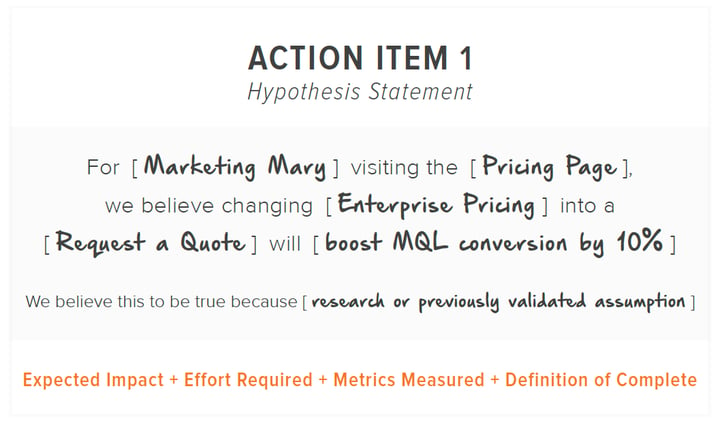
This process can be applied to anything from the design of the ad, to the experience of the page, to the subject line on an e-mail.
A/B Tests and other kinds of tests
The most well known type of test that can be done to prove or disprove an hypothesis is the A/B test.
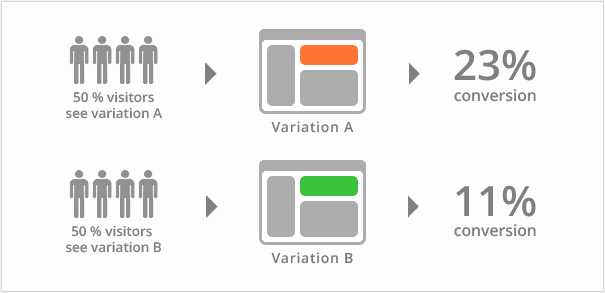
All aspects of digital marketing can go through a process of optimization using A/B testing, from the ad copy down to the form submission button in the landing page.
The standard approach is to test the 2 variations until statistical confidence -or significance- (in essence the probability that the difference in performance isn't just mere chance).
A quick note on statistical significance
When it comes to landing pages, however the truth is, most pages don't get enough traffic to be A/B testing at high levels and reaching statistical confidence. Statistical confidence (or signifgance) still produces false positives and you're more likely to encounter them at small traffic volumes.
What to test exactly?
To boost SEM ROI, you need to focus on creating SEM efficiencies.
An SEM efficiency is any A/B test-based tactic you can employ to increase conversions, conversion value and SEM ROI, all while lowering ad spending. There are many opportunities throughout the funnel to use these methods:
- Keyword bids
- Ad impressions
- Ad clicks
- Landing page click throughs
- Conversions
You have an opportunity to create SEM efficiencies and boost your SEM ROI in each each one of these steps. How’s that possible?
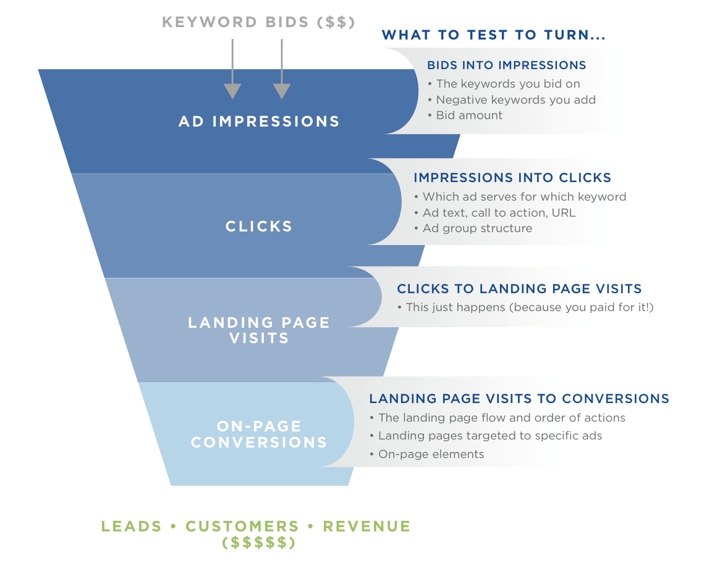
To turn keyword bids into impressions, A/B test:
- The keywords you bid on
- Any negative keywords you include
- The bid amount
To turn ad impressions into ad licks, A/B test:
- What ad is served for what specific keyword
- The ad text, URL and call to action
- The ad group layout
Ad clicks automatically turn into landing page visits, so we’ll skip that to move on to turning landing page click throughs into actual conversions. To turn landing page visits into conversions, A/B test:
- The value proposition
- The page’s information architecture and user flows
- Landing pages that are targeted to specific ads
- The elements on the page
SEM ROI - from impossible to inevitable
Now that you’ve diligently and regularly A/B tested everything you conceivably could, your SEM ROI gets an inevitable lift because:
- You’re no longer wasting money – Since you’re A/B testing all the different parts of your funnel, you’re able to increase the relevance of your paid ads and landing pages to users and leads. This works to lower how much you have to spend per click, which can equal thousands and tens of thousands of savings depending on how big your marketing campaign is.
- You’re lifting your conversion rate – A/B testing how to optimize your landing page for conversions will lead to a bigger conversion rate, thus leading to more sales and revenue.
- You’re boosting conversion value – When you optimize the landing page, you’re also increasing the average order value per conversion since a smoother and more relevant process encourages people to spend more.
- You’re discovering optimization possibilities on other channels – By A/B testing your landing page, you’ll understand what message, copy and design need to be. You can simply translate this data to your display ads and even outbound or offline ads.
- You’re boosting your ROI – This is the biggest benefit. Your SEM ROI will get better, whether it’s based on looking at direct sales and revenue or lifetime customer value ROI.
How to Bring Your Team on Board
Whether you take care of your SEM in-house or outsource it, to really boost your ROI you are going to need to bring a new player to the team: A Conversion specialist.

Working together
Most SEM professionals who have really mastered the science of optimizing your ads, have a consistent repeatable process, so modifying that process to accommodate the new CRO kid on the block can at times be challenging. But in most cases, it's a challenge worth figuring out.
To drum up support you'll need to take your team through a few realizations:
- Start measuring the performance of SEM, not in terms of Click-Thru rates and Cost-Per-Action (CPA), but in terms of actual conversions, leads generated, and revenue. Once the team realizes that the only measure that matters is revenue, things will start changing in your organization.
- Establish an SEM ROI task force that involves both SEM and CRO people, with the specific purpose of identifying key drivers of performance (revenue)
- Setup an agile improvement process such as Growth-Driven Design in which all potential improvements get prioritized by value to the organization - whatever is likely to have the biggest impact gets done first.
Remember that the case you must make to them is one based on profitability and doing what’s best to ensure a return on the money your company spends on SEM in the first place.
Instead of ONLY spending an arm and a leg on PPC specialists or SEM marketing consultants who only worry about getting impressions for paid ads, but then not to follow through with click throughs and conversions where it counts most, spend money on a great conversion expert."
Conclusion
Many business owners, marketers and consultants understand SEM, but the dilemma is that few of them understand how important is CRO to complement SEM so that your initial investment is worth it at all. Many companies even stop investing in SEM altogether without ever trying to optimize their conversions.
Implementing a solid, systematic conversion optimization program helps because it enables data-driven testing and decisions to ensure that your campaigns are performing as best as possible throughout the funnel from impression-to-conversion.
By regularly A/B testing different parts of your funnel, you get to identify SEM efficiencies and where you need to improve things to bump up your conversion rate on your ultimate landing page or homepage.
Lastly, even if you’re convinced that this approach is the best way forward, you may still run into some opposition from some on your team, mostly because of inertia... they have been doing things in a way for a while... that's difficult to change. But start by setting up the right revenue impact metrics and go from there. Once you already have the data in your favor; all you have to do now is facilitate interactions between the SEM and CRO experts to work as one team.
How about in your company - have you run into trouble integrating a proper Conversion Optimization process in your organization? How have you handled it?



